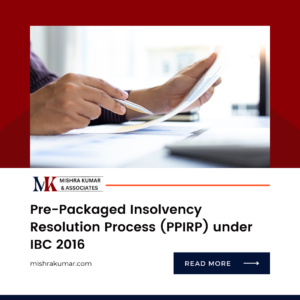Navigating the Insolvency and Bankruptcy Process for Financial Creditors
The Insolvency and Bankruptcy Code (IBC) in India provides a structured framework for the resolution of financial distress faced by corporate entities. Financial creditors, who have extended credit facilities to borrowers, play a significant role in this process. In this blog, we will explore the insolvency and bankruptcy process for financial creditors, emphasizing the importance of professional assistance in effectively managing their claims and interests.
INTRODUCTION
The Insolvency and Bankruptcy Code (IBC) in India provides a structured framework for the resolution of financial distress faced by corporate entities. Financial creditors, who have extended credit facilities to borrowers, play a significant role in this process. In this blog, we will explore the insolvency and bankruptcy process for financial creditors, emphasizing the importance of professional assistance in effectively managing their claims and interests.
ANALYSIS
Understanding the Insolvency and Bankruptcy Process for Financial Creditors
Before discussing the role of professional assistance, let’s clarify what the insolvency and bankruptcy process for financial creditors entails:
Financial Creditor: A financial creditor is an entity that has extended credit or financial facilities to a borrower, leading to a financial debt obligation.
Insolvency Resolution Process (IRP): When a corporate debtor defaults on its financial debt obligations, the IRP is initiated. An insolvency professional is appointed as the IRP to manage the resolution process.
Committee of Creditors (CoC): Financial creditors form the CoC, which plays a central role in evaluating resolution plans, making key decisions, and protecting the interests of creditors.
Resolution Plan: During the IRP, resolution applicants submit plans to revive the corporate debtor. The CoC evaluates these plans and selects the most viable one.
Liquidation: If a resolution plan is not accepted or the IRP period expires without resolution, the company proceeds to liquidation. Liquidation involves the sale of assets to repay creditors.
Importance of Professional Assistance
Why is professional assistance crucial for financial creditors in the insolvency and bankruptcy process?
Legal Expertise: Insolvency and bankruptcy proceedings involve complex legal provisions. Legal professionals guide financial creditors through the process, ensuring compliance with regulations and protecting their legal rights.
Claim Assessment: Professionals assist financial creditors in assessing their claims, including the verification of the outstanding debt amount.
CoC Representation: Professionals represent financial creditors in the CoC, making informed decisions on resolution plans and other critical matters.
Negotiation and Settlement: Skilled negotiators work on behalf of financial creditors to secure favorable agreements with resolution applicants or the corporate debtor.
Resolution Plan Evaluation: Experts assist financial creditors in evaluating resolution plans to ensure they align with their interests and maximize recovery.
Part 3: The Insolvency and Bankruptcy Assistance Process for Financial Creditors
The assistance process for financial creditors in insolvency and bankruptcy generally involves the following steps:
Claim Verification: Financial creditors verify and submit their claims to the IRP for inclusion in the list of creditors.
Legal Consultation: Legal experts provide guidance on the rights and obligations of financial creditors under insolvency laws.
CoC Representation: Professionals represent financial creditors in CoC meetings, making decisions on resolution plans and other matters.
Negotiation and Resolution: Negotiations with resolution applicants or the corporate debtor are conducted to secure favorable agreements.
Resolution Plan Evaluation: Experts assess resolution plans to ensure they are in the best interest of financial creditors.
CONCLUSION
The insolvency and bankruptcy process for financial creditors is a complex and critical aspect of India’s insolvency framework. Professional assistance provides financial creditors with the legal expertise, claim assessment, CoC representation, negotiation skills, and resolution plan evaluation needed to effectively manage their interests and maximize recovery.
As India’s insolvency landscape continues to evolve, the role of professionals in assisting financial creditors remains instrumental in achieving equitable resolutions that protect the interests of creditors and stakeholders.
FAQs
Q1: How are financial creditors’ claims assessed during the insolvency process?
A1: Financial creditors submit their claims to the IRP, who verifies and includes them in the list of creditors. The claims are then evaluated during the insolvency resolution process.
Q2: What happens if financial creditors disagree on the acceptance of a resolution plan?
A2: If financial creditors disagree on the acceptance of a resolution plan, the decision is typically made by a vote in the Committee of Creditors (CoC). The plan with the highest percentage of votes is accepted.
Q3: Can financial creditors opt for liquidation if they believe it is more favorable than any resolution plan?
A3: Yes, financial creditors can vote for liquidation if they believe it is in their best interest and is more favorable than any available resolution plan. The CoC’s decision is based on a majority vote.
RECENT POSTS
- The implication of Stamp Duty on Scheme of Arrangement (Merger & Amalgamation):
- Pre-Packaged Insolvency Resolution Process (PPIRP) under IBC 2016
- BUY BACK OF SHARES V/S DIVIDEND
- Comprehensive comparative analysis of SEBI (Listing Obligations and Disclosure Requirements) (Second Amendment) Regulations, 2021.
- SEBI (Delisting of Equity Shares) Regulations, 2021-Imposes new responsibilities on the board of directors.

The implication of Stamp Duty on Scheme of Arrangement (Merger & Amalgamation):
The implication of Stamp Duty on Scheme of Arrangement (Merger & Amalgamation): The Scheme of Arrangement is a legal mechanism under corporate law that allows

Pre-Packaged Insolvency Resolution Process (PPIRP) under IBC 2016
Pre-Packaged Insolvency Resolution Process (PPIRP) under IBC 2016 The Insolvency and Bankruptcy Code (IBC) 2016, is a comprehensive legislation aimed at consolidating and amending laws

BUY BACK OF SHARES V/S DIVIDEND
BUY-BACK OF SHARES V/S DIVIDEND A dividend offers cash rewards to all shareholders in accordance with their stake in the company, whereas a share buyback

Comprehensive comparative analysis of SEBI (Listing Obligations and Disclosure Requirements) (Second Amendment) Regulations, 2021.
Comprehensive comparative analysis of SEBI (Listing Obligations and Disclosure Requirements) (Second Amendment) Regulations, 2021. Securities and Exchange Board of India (“SEBI”) vide notification dated May

SEBI (Delisting of Equity Shares) Regulations, 2021-Imposes new responsibilities on the board of directors.
SEBI (Delisting of Equity Shares) Regulations, 2021-Imposes new responsibilities on the board of directors. Securities and Exchange Board of India (“SEBI”) vide notification dated 10th

Summary of Insolvency and Bankruptcy Board of India (Liquidation Process) (Amendment) Regulations, 2024
Summary of Insolvency and Bankruptcy Board of India (Liquidation Process) (Amendment) Regulations, 2024 The Insolvency and Bankruptcy Board of India (IBBI) recently issued amendments to

